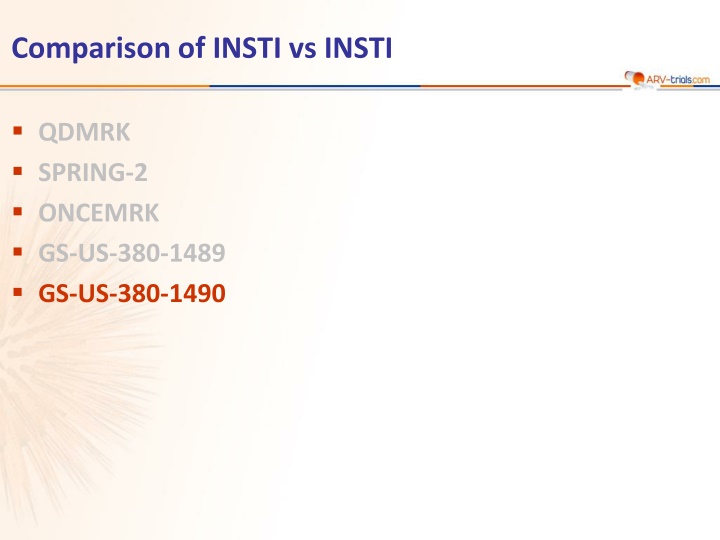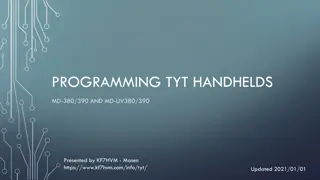
Comparison of INSTI vs. INSTI.QD: Study GS-US-380-1490
This study, GS-US-380-1490, compares the efficacy of BIC/F/TAF QD versus DTG+F/TAF QD in ARV-naive HIV patients. The study focuses on virologic outcomes at week 48, baseline characteristics, patient disposition, and adverse events. Non-inferiority of BIC/F/TAF at week 48 was assessed based on various parameters like HIV RNA levels and CD4 cell counts. The results indicate no resistance emergence and high virologic response rates with BIC/F/TAF treatment. Further details on the study and its findings can be explored through the provided images and references.
Download Presentation

Please find below an Image/Link to download the presentation.
The content on the website is provided AS IS for your information and personal use only. It may not be sold, licensed, or shared on other websites without obtaining consent from the author. If you encounter any issues during the download, it is possible that the publisher has removed the file from their server.
You are allowed to download the files provided on this website for personal or commercial use, subject to the condition that they are used lawfully. All files are the property of their respective owners.
The content on the website is provided AS IS for your information and personal use only. It may not be sold, licensed, or shared on other websites without obtaining consent from the author.
E N D
Presentation Transcript
Comparison of INSTI vs INSTI QDMRK SPRING-2 ONCEMRK GS-US-380-1489 GS-US-380-1490
Study GS-US-380-1490: BIC/F/TAF QD vs DTG + F/TAF QD Design Randomisation* 1 : 1 Double-blind W48 W144 > 18 years ARV-na ve HIV RNA > 500 c/mL Any CD4 cell count eGFR 30 mL/min No resistance to FTC or TDF HBV or HCV co- infection allowed N = 320 BIC/F/TAF QD DTG + F/TAF placebo QD DTG + F/TAF QD N = 325 BIC/F/TAF placebo QD * Randomisation was stratified by HIV RNA (< 100 000 c/mL, 100 000-4000 000 c/mL or > 100 000 c/mL), CD4 (< 50/mm3, 50-199/mm3or 200/mm3) at screening and geographic region (USA vs non-USA) BIC/F/TAF : 50/200/25 mg, as STR Objective Non inferiority of BIC/F/TAF at W48: % HIV RNA < 50 c/mL by intention to treat, snapshot analysis (lower margin of the 2-sided 95.002% CI for the difference= -12%, 95% power) Sax PE. Lancet. 2017 Nov 4;390(10107):2073-2082. GS-US-380-1490
Study GS-US-380-1490: BIC/F/TAF QD vs DTG + F/TAF QD Baseline characteristics and patient disposition BIC/F/TAF N = 320 DTG + F/TAF N = 325 Median age, years 33 34 Female, % 12 11 HIV RNA (log10 c/mL), median HIV RNA > 100 000 c/mL, % 4.43 4.45 21 17 CD4 cell count (/mm3), median 440 441 CD4 < 200/mm3, % 14 10 HBV/HCV co-infection, % 3 / 2 2 /2 Discontinuation by W48, % 9 6 For lack of efficacy, N 0 0 For adverse event, N 5 1 Lost to follow-up, N 8 5 Non-compliance 0 2 Patient decision / investigator discretion 7 / 4 7 / 0 Other 4 5 Sax PE. Lancet. 2017 Nov 4;390(10107):2073-2082. GS-US-380-1490
Study GS-US-380-1490: BIC/F/TAF QD vs DTG + F/TAF QD Virologic outcome at week 48 % 100 92.9 89.4 BIC/F/TAF DTG + F/TAF Difference (95 % CI) 80 DTG + F/TAF BIC/F/TAF 60 - 3.5 40 - 7.9 1.0 20 + 12% 12% Met criteria for resistance testing (HIV RNA 200 c/mL) BIC/F/TAF: 7 vsDTG + F/TAF: 5 No resistance emergence Mean CD4 increase at W48 BIC/F/TAF: + 180/mm3 DTG + F/TAF: + 201/mm3 0 6 6 4 1 0 HIV RNA < 50 c/mL HIV RNA 50 c/mL No data HIV RNA < 50 c/mL (per-protocol) BIC/F/TAF: 98.9% DTG + F/TAF: 99.7% Sax PE. Lancet. 2017 Nov 4;390(10107):2073-2082. GS-US-380-1490
Study GS-US-380-1490: BIC/F/TAF QD vs DTG + F/TAF QD Adverse events BIC/F/TAF N = 320 5 * DTG + F/TAF N = 325 1 ** Adverse events leading to study drug discontinuation, N Adverse event 5% in either group, % Headache Diarrhea Nausea Nasopharyngitis Fatigue Influenza Lymphadenopathy Arthralgia Insomnia Upper respiratory tract infection Pyrexia Back pain Grade 3-4 laboratory abnormalities, % CK elevation LDL-cholesterol elevation ALT / AST elevation Hyperglycemia * Abdominal distension ; Cardiac arrest (sepsis, appendicitis) ; Chest pain ; Paranoia, crystal metamphetamine use ; sleep disorders, insomnia, dyspepsia, tension headache, depressed mood ** Erythema, pruritus 12.5 11.6 7.8 6.9 5.9 5.3 5.3 5.0 5.0 4.7 4.4 3.4 12.3 12.0 8.9 9.5 8.0 3.1 5.5 2.8 4.3 7.1 6.5 6.2 3.5 3.0 2.2 3.5 2.2 / 1.3 0.3 0.9 / 2.5 2.2 Sax PE. Lancet. 2017 Nov 4;390(10107):2073-2082. GS-US-380-1490
Study GS-US-380-1490: BIC/F/TAF QD vs DTG + F/TAF QD Change from baseline in eGFR and lipids at W48 BIC/F/TAF DTG + F/TAF p N = 314 N = 315 Median change in eGFR (Cockroft-Gault), mL/min - 7.3 - 10.8 0.0181 Mean changes in fasting lipids, mg/dL Total cholesterol LDL cholesterol HDL cholesterol Triglycerides 12 9 5 3 15 12 5 7 ns No discontinuations due to renal adverse events and no proximal tubulopathy in either arm Sax PE. Lancet. 2017 Nov 4;390(10107):2073-2082. GS-US-380-1490
Study GS-US-380-1490: BIC/F/TAF QD vs DTG + F/TAF QD Steady-state pharmacokinetic parameters of BIC/F/TAF (N = 17) Bictegravir FTC TAF AUCtau (hr*ng/mL) Mean (% CV ; min-max) 101 120.5 11 238.1 259.4 (43.8 ; 55 065.7-216 295) (28.4 ; 5 621.6-18 876.7) (59.9 ; 63.1-710.2) Cmax (ng/mL) Mean (% CV ; min-max) 7 339.4 1 920 309.4 (37.3 ; 4 170-13 300) (20.7 ; 1 380-2 820) (59.9 ; 63.3-764) Ctau (ng/mL) * Mean (% CV ; min-max) 2 576.0 ** (52.0 ; 800-5 690) 97.7 - (38.4 ; 47-169) Tmax(h) Median (Q1-Q3) 1.02 (1.00-2.97) 1.02 (1.00-1.50) 0.50 (0.50-1.02) t1/2 (h) Median (Q1-Q3) 18.56 (15.51-20.14) 7.05 (6.39-7.35) 0.43 (0.31-0.56) * N = 15 ** BIC mean Ctauabout 16 times higher than the protein adjusted effective concentration (162 ng/mL) against wild type HIV-1 virus Sax PE. Lancet. 2017 Nov 4;390(10107):2073-2082.
Study GS-US-380-1490: BIC/F/TAF QD vs DTG + F/TAF QD Summary of week 48 results Virologic suppression at W48 was high in both arms, with BIC/F/TAF being non inferior to DTG + F/TAF in treatment-na ve adults Sensitivity analyses confirmed BIC/F/TAF was non inferior to DTG + F/TAF No patient discontinued either treatment arm due to lack of efficacy No treatment-emergent resistance to any study medication was observed in either arm BIC/F/TAF was safe and well tolerated Less decrease in eGFRCGwas observed with BIC/F/TAF vs DTG + F/TAF There were no discontinuations due to renal adverse events and no cases of renal tubulopathy, including Fanconi syndrome, in either treatment group Changes from baseline in lipid parameters were equivalent Sax PE. Lancet. 2017 Nov 4;390(10107):2073-2082. GS-US-380-1490

